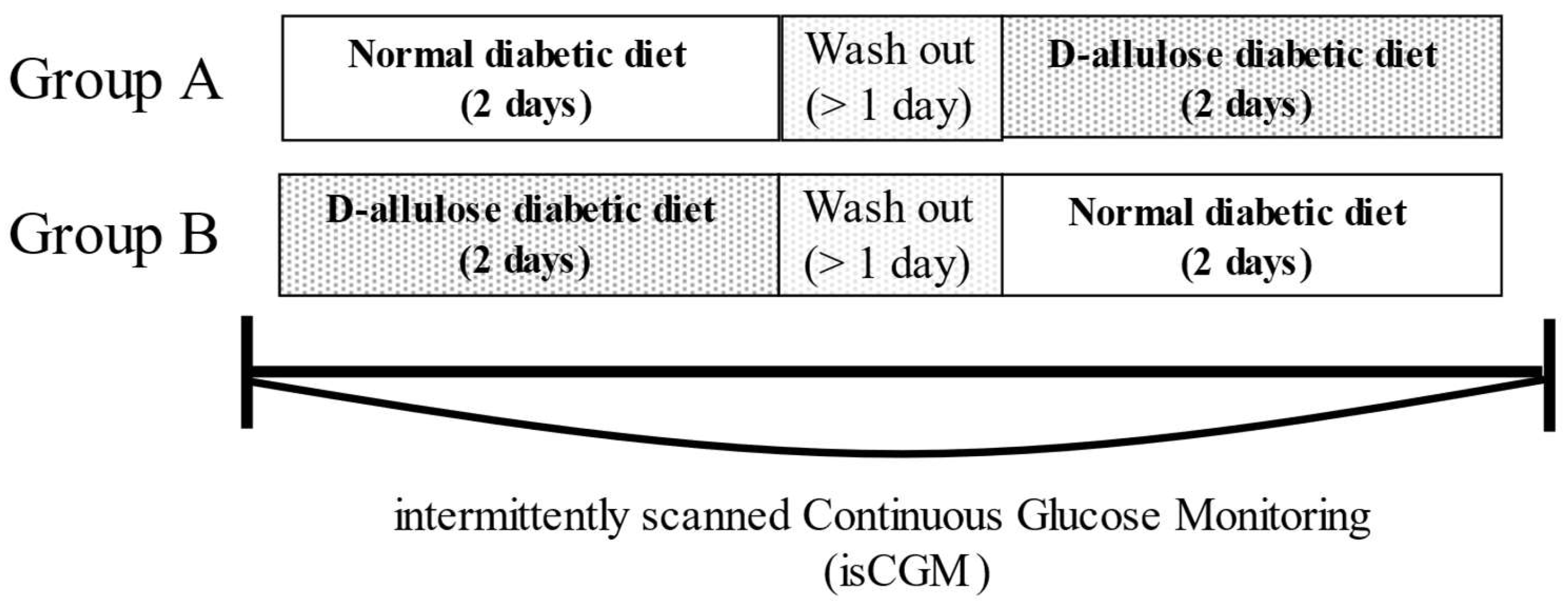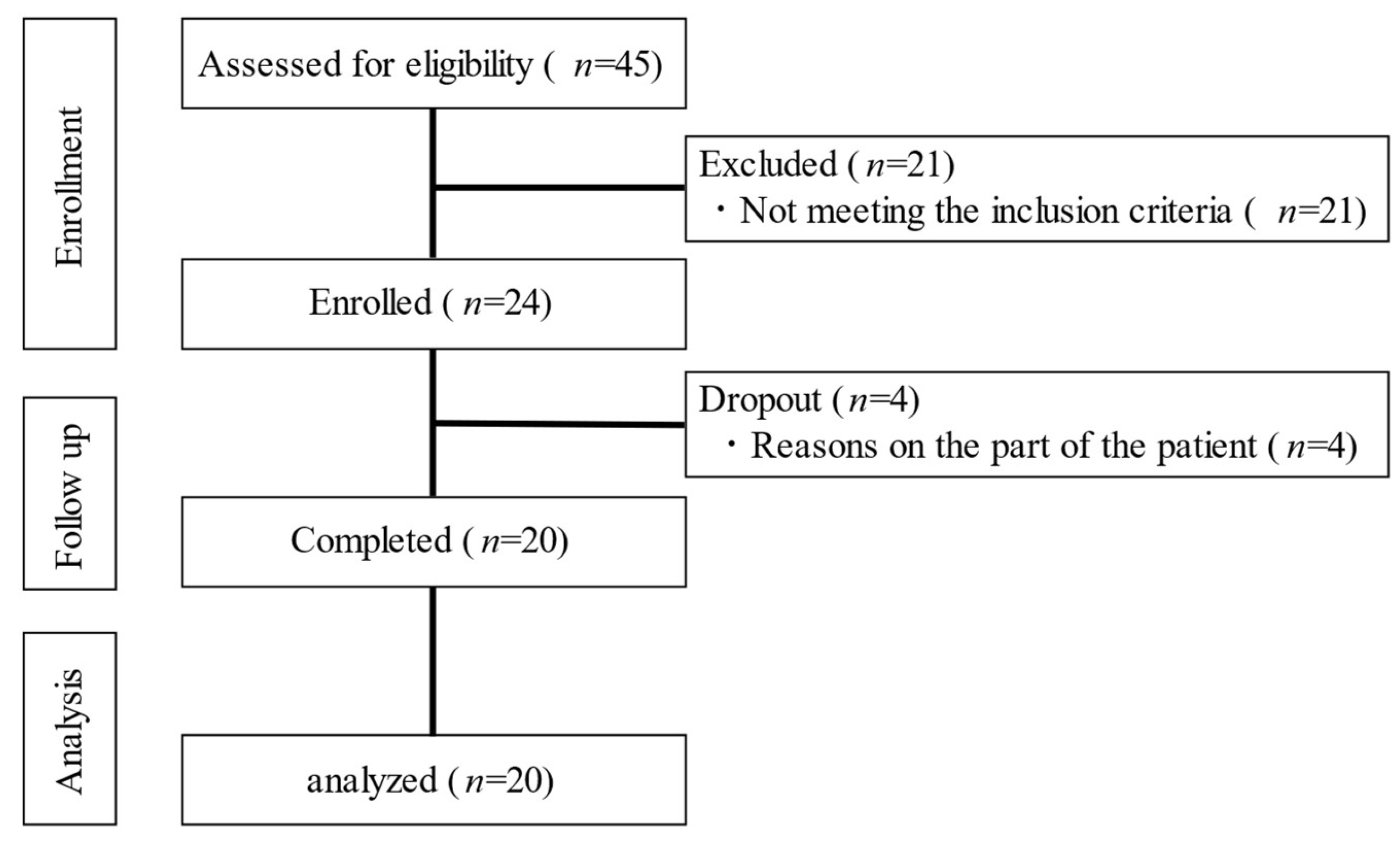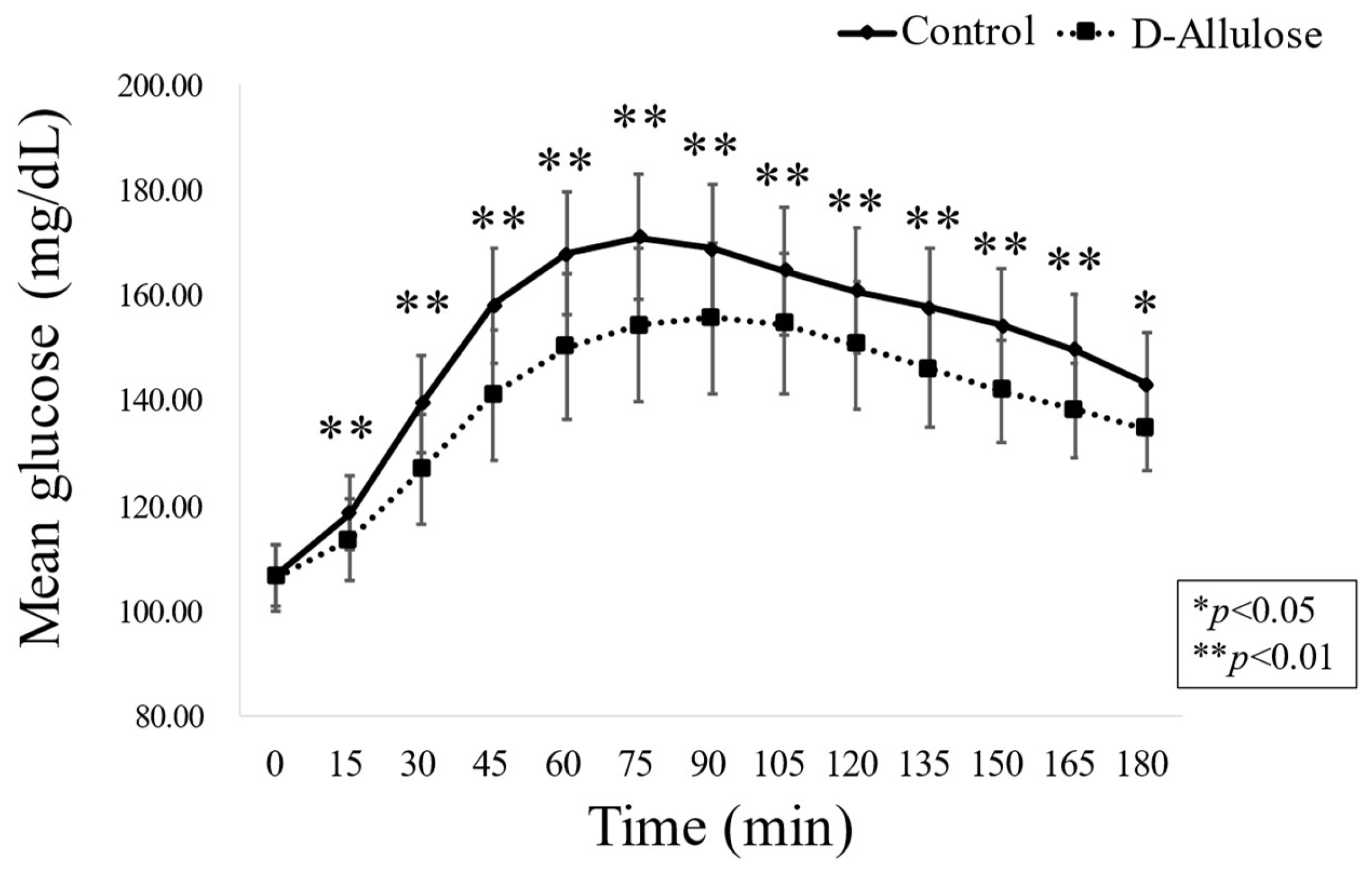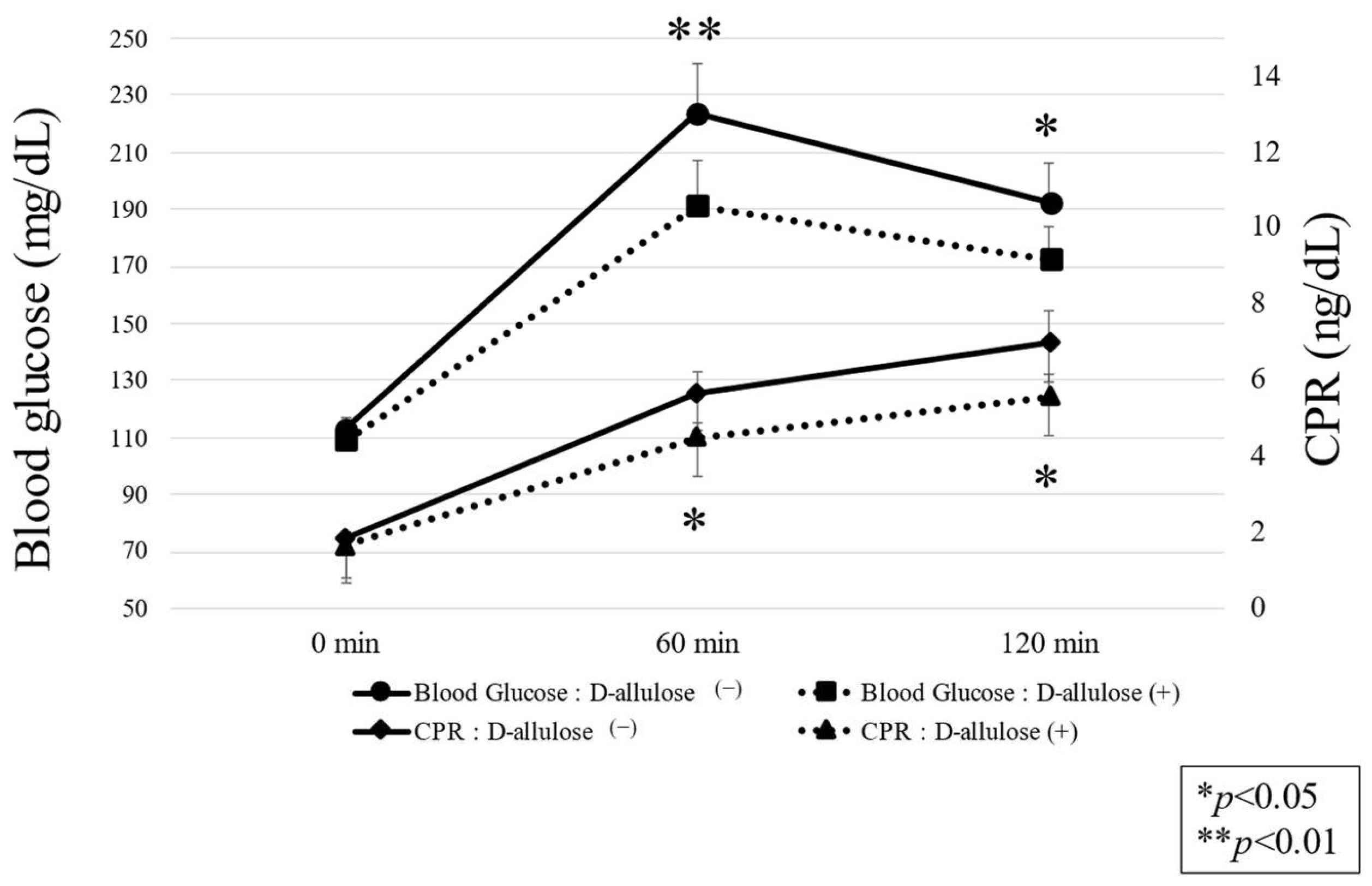A Pilot Study on the Efficacy of a Diabetic Diet Containing the Rare Sugar D-Allulose in Patients with Type 2 Diabetes Mellitus: A Prospective, Randomized, Single-Blind, Crossover Study
Abstract
1. Introduction
2. Methods
2.1. Study Design
2.2. Participants
2.3. Study Food
2.4. Glycemic Measures
2.5. Outcome Measures
2.6. Statistical Analysis
3. Results
3.1. Participant Characteristics
3.2. Effect of D-Allulose on Postprandial Peak Glucose
3.3. Postprandial Blood Glucose Levels When Using IsCGM
3.4. Patient Questionnaire on Seasoning
3.5. Side Effects of D-Allulose
4. Discussion
Author Contributions
Funding
Institutional Review Board Statement
Informed Consent Statement
Data Availability Statement
Acknowledgments
Conflicts of Interest
References
- Magliano, D.J.; Boyko, E.J.; IDF Diabetes Atlas 10th Edition Scientific Committee. IDF Diabetes Atlas, 10th ed.; International Diabetes Federation: Brussels, Belgium, 2021; ISBN 978-2-930229-98-0. [Google Scholar]
- Beulens, J.W.J.; de Bruijne, L.M.; Stolk, R.P.; Peeters, P.H.M.; Bots, M.L.; Grobbee, D.E.; van der Schouw, Y.T. High Dietary Glycemic Load and Glycemic Index Increase Risk of Cardiovascular Disease Among Middle-Aged Women: A Population-Based Follow-Up Study. J. Am. Coll. Cardiol. 2007, 50, 14–21. [Google Scholar] [CrossRef] [PubMed]
- Imamura, F.; O’Connor, L.; Ye, Z.; Mursu, J.; Hayashino, Y.; Bhupathiraju, S.N.; Forouhi, N.G. Consumption of Sugar Sweetened Beverages, Artificially Sweetened Beverages, and Fruit Juice and Incidence of Type 2 Diabetes: Systematic Review, Meta-Analysis, and Estimation of Population Attributable Fraction. BMJ 2015, 351, h3576. [Google Scholar] [CrossRef] [PubMed]
- Gardner, C.; Wylie-Rosett, J.; Gidding, S.S.; Steffen, L.M.; Johnson, R.K.; Reader, D.; Lichtenstein, A.H.; American Heart Association Nutrition Committee of the Council on Nutrition, Physical Activity and Metabolism, Council on Arteriosclerosis, Thrombosis and Vascular Biology, Council on Cardiovascular Disease in the Young; American Diabetes Association. Nonnutritive Sweeteners: Current Use and Health Perspectives: A Scientific Statement from the American Heart Association and the American Diabetes Association. Diabetes Care 2012, 35, 1798–1808. [Google Scholar] [CrossRef] [PubMed]
- Suez, J.; Korem, T.; Zeevi, D.; Zilberman-Schapira, G.; Thaiss, C.A.; Maza, O.; Israeli, D.; Zmora, N.; Gilad, S.; Weinberger, A.; et al. Artificial Sweeteners Induce Glucose Intolerance by Altering the Gut Microbiota. Nature 2014, 514, 181–186. [Google Scholar] [CrossRef]
- Suez, J.; Cohen, Y.; Valdés-Mas, R.; Mor, U.; Dori-Bachash, M.; Federici, S.; Zmora, N.; Leshem, A.; Heinemann, M.; Linevsky, R.; et al. Personalized Microbiome-Driven Effects of Non-Nutritive Sweeteners on Human Glucose Tolerance. Cell 2022, 185, 3307–3328.e19. [Google Scholar] [CrossRef]
- Fowler, S.P.; Williams, K.; Resendez, R.G.; Hunt, K.J.; Hazuda, H.P.; Stern, M.P. Fueling the Obesity Epidemic? Artificially Sweetened Beverage Use and Long-Term Weight Gain. Obesity 2008, 16, 1894–1900. [Google Scholar] [CrossRef]
- Elfhag, K.; Tynelius, P.; Rasmussen, F. Sugar-Sweetened and Artificially Sweetened Soft Drinks in Association to Restrained, External and Emotional Eating. Physiol. Behav. 2007, 91, 191–195. [Google Scholar] [CrossRef]
- Hossain, M.A.; Izuishi, K.; Maeta, H. Protective Effects of D-Allose against Ischemia Reperfusion Injury of the Rat Liver. J. Hepatobiliary Pancreat. Surg. 2003, 10, 218–225. [Google Scholar] [CrossRef]
- Tsukamoto, I.; Hossain, A.; Yamaguchi, F.; Hirata, Y.; Dong, Y.; Kamitori, K.; Sui, L.; Nonaka, M.; Ueno, M.; Nishimoto, K.; et al. Intestinal Absorption, Organ Distribution, and Urinary Excretion of the Rare Sugar D-Psicose. Drug Des. Devel. Ther. 2014, 8, 1955–1964. [Google Scholar] [CrossRef]
- Hishiike, T.; Ogawa, M.; Hayakawa, S.; Nakajima, D.; O’Charoen, S.; Ooshima, H.; Sun, Y. Transepithelial Transports of Rare Sugar D-Psicose in Human Intestine. J. Agric. Food Chem. 2013, 61, 7381–7386. [Google Scholar] [CrossRef]
- Kishida, K.; Martinez, G.; Iida, T.; Yamada, T.; Ferraris, R.P.; Toyoda, Y. D-Allulose Is a Substrate of Glucose Transporter Type 5 (GLUT5) in the Small Intestine. Food Chem. 2019, 277, 604–608. [Google Scholar] [CrossRef] [PubMed]
- Iida, T.; Kishimoto, Y.; Yoshikawa, Y.; Hayashi, N.; Okuma, K.; Tohi, M.; Yagi, K.; Matsuo, T.; Izumori, K. Acute D-Psicose Administration Decreases the Glycemic Responses to an Oral Maltodextrin Tolerance Test in Normal Adults. J. Nutr. Sci. Vitaminol. 2008, 54, 511–514. [Google Scholar] [CrossRef] [PubMed]
- Matsuo, T.; Tanaka, T.; Hashiguchi, M.; Izumori, K.; Suzuki, H. Metabolic Effects of D-Psicose in Rats: Studies on Faecal and Urinary Excretion and Caecal Fermentation. Asia Pac. J. Clin. Nutr. 2003, 12, 225–231. [Google Scholar]
- Hossain, A.; Yamaguchi, F.; Hirose, K.; Matsunaga, T.; Sui, L.; Hirata, Y.; Noguchi, C.; Katagi, A.; Kamitori, K.; Dong, Y.; et al. Rare Sugar D-Psicose Prevents Progression and Development of Diabetes in T2DM Model Otsuka Long-Evans Tokushima Fatty Rats. Drug Des. Devel. Ther. 2015, 9, 525–535. [Google Scholar] [CrossRef]
- Iwasaki, Y.; Sendo, M.; Dezaki, K.; Hira, T.; Sato, T.; Nakata, M.; Goswami, C.; Aoki, R.; Arai, T.; Kumari, P.; et al. GLP-1 Release and Vagal Afferent Activation Mediate the Beneficial Metabolic and Chronotherapeutic Effects of D-Allulose. Nat. Commun. 2018, 9, 113. [Google Scholar] [CrossRef] [PubMed]
- Hayashi, N.; Iida, T.; Yamada, T.; Okuma, K.; Takehara, I.; Yamamoto, T.; Yamada, K.; Tokuda, M. Study on the Postprandial Blood Glucose Suppression Effect of D-Psicose in Borderline Diabetes and the Safety of Long-Term Ingestion by Normal Human Subjects. Biosci. Biotechnol. Biochem. 2010, 74, 510–519. [Google Scholar] [CrossRef] [PubMed]
- Japar, S.; Fukunaga, K.; Kobayashi, T.; Imachi, H.; Sato, S.; Saheki, T.; Ibata, T.; Yoshimura, T.; Soh, K.L.; Ong, S.L.; et al. A Pilot Study on the Effect of D-Allulose on Postprandial Glucose Levels in Patients with Type 2 Diabetes Mellitus during Ramadan Fasting. Diabetol. Metab. Syndr. 2022, 14, 86. [Google Scholar] [CrossRef] [PubMed]
- Yuma, T.; Tokuda, M.; Nishimoto, N.; Yokoi, H.; Izumori, K. Allulose for the Attenuation of Postprandial Blood Glucose Levels in Healthy Humans: A Systematic Review and Meta-Analysis. PLoS ONE 2023, 18, e0281150. [Google Scholar] [CrossRef]
- Noronha, J.C.; Braunstein, C.R.; Glenn, A.J.; Khan, T.A.; Viguiliouk, E.; Noseworthy, R.; Blanco Mejia, S.; Kendall, C.W.C.; Wolever, T.M.S.; Leiter, L.A.; et al. The Effect of Small Doses of Fructose and Allulose on Postprandial Glucose Metabolism in Type 2 Diabetes: A Double-Blind, Randomized, Controlled, Acute Feeding, Equivalence Trial. Diabetes Obes. Metab. 2018, 20, 2361–2370. [Google Scholar] [CrossRef]
- Iida, T. Estimation of Maximum Non-Effective Level of D-Psicose in Causing Diarrhea in Human Subjects. J. Adv. Food Ingred. 2007, 10, 15–19. [Google Scholar]
- Han, Y.; Choi, B.R.; Kim, S.Y.; Kim, S.-B.; Kim, Y.H.; Kwon, E.-Y.; Choi, M.-S. Gastrointestinal Tolerance of D-Allulose in Healthy and Young Adults. A Non-Randomized Controlled Trial. Nutrients 2018, 10, 2010. [Google Scholar] [CrossRef]
- Araki, E.; Goto, A.; Kondo, T.; Noda, M.; Noto, H.; Origasa, H.; Osawa, H.; Taguchi, A.; Tanizawa, Y.; Tobe, K.; et al. Japanese Clinical Practice Guideline for Diabetes 2019. J. Diabetes Investig. 2020, 11, 1020–1076. [Google Scholar] [CrossRef]
- Rebrin, K.; Steil, G.M. Can Interstitial Glucose Assessment Replace Blood Glucose Measurements? Diabetes Technol. Ther. 2000, 2, 461–472. [Google Scholar] [CrossRef]
- Shintani, T.; Yamada, T.; Hayashi, N.; Iida, T.; Nagata, Y.; Ozaki, N.; Toyoda, Y. Rare Sugar Syrup Containing D-Allulose but Not High-Fructose Corn Syrup Maintains Glucose Tolerance and Insulin Sensitivity Partly via Hepatic Glucokinase Translocation in Wistar Rats. J. Agric. Food Chem. 2017, 65, 2888–2894. [Google Scholar] [CrossRef]
- Meier, J.J. GLP-1 Receptor Agonists for Individualized Treatment of Type 2 Diabetes Mellitus. Nat. Rev. Endocrinol. 2012, 8, 728–742. [Google Scholar] [CrossRef]
- Sun, Y.; Hayakawa, S.; Ogawa, M.; Fukada, K.; Izumori, K. Influence of a Rare Sugar, d-Psicose, on the Physicochemical and Functional Properties of an Aerated Food System Containing Egg Albumen. J. Agric. Food Chem. 2008, 56, 4789–4796. [Google Scholar] [CrossRef]
- Jürkenbeck, K.; Haarhoff, T.; Spiller, A.; Schulze, M. Does Allulose Appeal to Consumers? Results from a Discrete Choice Experiment in Germany. Nutrients 2022, 14, 3350. [Google Scholar] [CrossRef]
- Saraiva, A.; Carrascosa, C.; Raheem, D.; Ramos, F.; Raposo, A. Natural Sweeteners: The Relevance of Food Naturalness for Consumers, Food Security Aspects, Sustainability and Health Impacts. Int. J. Environ. Res. Public. Health 2020, 17, 6285. [Google Scholar] [CrossRef] [PubMed]
- Lim, S.-L.; Penrod, M.T.; Ha, O.-R.; Bruce, J.M.; Bruce, A.S. Calorie Labeling Promotes Dietary Self-Control by Shifting the Temporal Dynamics of Health- and Taste-Attribute Integration in Overweight Individuals. Psychol. Sci. 2018, 29, 447–462. [Google Scholar] [CrossRef] [PubMed]
- Tanaka, M.; Hayashi, N.; Iida, T. Safety Evaluation of 12-Week Continuous Ingestion of D-Allulose in Borderline Diabetes and Type 2 Diabetes. Fundam. Toxicol. Sci. 2019, 6, 225–234. [Google Scholar] [CrossRef]
- Tak, J.; Bok, M.; Rho, H.; Park, J.H.; Lim, Y.; Chon, S.; Lim, H. Effect of Diabetes-Specific Oral Nutritional Supplements with Allulose on Weight and Glycemic Profiles in Overweight or Obese Type 2 Diabetic Patients. Nutr. Res. Pract. 2023, 17, 241–256. [Google Scholar] [CrossRef] [PubMed]






| Overall | Control First Group | D-Allulose First Group | p-Value | |
|---|---|---|---|---|
| Gender | ||||
| Male | 14 (70.0%) | 6 (60.0%) | 8 (80.0%) | |
| Female | 6 (30.0%) | 4 (40.0%) | 2 (20.0%) | |
| Age (years old) | 61.0 (11.9) | 65.3 (7.3) | 56.3 (14.0) | 0.08 |
| Duration of diabetes | 10.6 (11.5) | 12.0 (13.5) | 9.2 (9.6) | 0.60 |
| Height (cm) | 159.6 (8.3) | 159.1 (10.0) | 160.1 (6.7) | 0.78 |
| Weight (kg) | 65.6 (14.2) | 61.1 (11.5) | 70.1 (15.8) | 0.16 |
| BMI (kg/m2) | 25.6 (4.2) | 24.2 (3.1) | 27.1 (4.8) | 0.11 |
| Grip strength (kg) | ||||
| Right (kg) | 30.2 (9.8) | 28.1 (9.6) | 32.3 (10.1) | 0.37 |
| Left (kg) | 29.8 (9.7) | 27.6 (8.0) | 31.9 (11.6) | 0.36 |
| sBP (mmHg) | 127 (19) | 128 (21) | 125 (16) | 0.72 |
| dBP (mmHg) | 73 (12) | 72 (14) | 73 (11) | 0.75 |
| Chemistry | ||||
| HbA1c (%) | 9.2 (1.8) | 9.3 (2.2) | 9.0 (1.4) | 0.69 |
| Fasting blood glucose (mg/dL) | 148 (39) | 152 (36) | 144 (45) | 0.69 |
| fasting IRI | 9.7 (5.5) | 10.2 (5.7) | 9.2 (5.6) | 0.72 |
| fasting CPR (ng/dL) | 2.15 (1.28) | 2.55 (1.63) | 1.76 (0.66) | 0.18 |
| Urinary CPR | 52.4 (35.0) | 55.2 (38.3) | 49.6 (33.1) | 0.73 |
| UACR (mg/g·Cre) | 38.1 (39.7) | 42.5 (50.7) | 33.7 (26.6) | 0.64 |
| Total cholesterol (mg/dL) | 159 (33) | 157 (20) | 161 (42) | 0.78 |
| LDL cholesterol (mg/dL) | 92 (30) | 89 (17) | 95 (40) | 0.69 |
| HDL cholesterol (mg/dL) | 40(12) | 39 (16) | 41 (8) | 0.70 |
| Triglyceride (mg/dL) | 137 (77) | 145 (60) | 128 (93) | 0.64 |
| BUN (mg/dL) | 17 (6) | 18 (8) | 15 (4) | 0.33 |
| Cre (mg/dL) | 0.75 (0.16) | 0.72 (0.19) | 0.78 (0.13) | 0.39 |
| eGFR (mL/min) | 78.9 (18.1) | 79.9 (21.9) | 77.9 (14.6) | 0.81 |
| AST (U/L) | 30 (23) | 35 (30) | 25 (13) | 0.32 |
| ALT (U/L) | 36 (34) | 42 (41) | 31 (25) | 0.48 |
| CVR-R (%) | 2.42 (1.09) | 1.96 (0.99) | 2.89 (1.03) | 0.05 |
| R-CAVI | 8.3 (1.6) | 8.9 (1.3) | 7.7 (1.8) | 0.08 |
| L-CABI | 7.92 (2.15) | 8.75 (1.15) | 7.10 (2.63) | 0.09 |
| R-ABI | 1.10 (0.14) | 1.12 (0.07) | 1.09 (0.19) | 0.70 |
| L-ABI | 1.10 (0.15) | 1.12 (0.11) | 1.08 (0.19) | 0.62 |
| Diabetec treatment | ||||
| OHAs | 9 (45%) | 5 (25%) | 4 (20%) | |
| GLP-1 RA and OHAs | 8 (40%) | 3 (15%) | 5 (25%) | |
| Insulin monotherapy | 1 (5%) | 1 (5%) | 0 | |
| Insulin and GLP-1 RA | 1 (5%) | 0 | 1 (5%) | |
| Insulin and GLP-1 RA | 1 (5%) | 1 (5%) | 0 | |
| and OHAs | ||||
| study foods | ||||
| energy (kcal/day) | target body weight [kg] × energy coefficient [kcal/kg] | |||
| carbohydrates (%energy) | 50–60% | |||
| proteins (%energy) | approximately 20% | |||
| fats (%energy) | remaining | |||
| n (%); Mean (SD) | ||||
| n | Control | D-Allulose | p-Value | ||
|---|---|---|---|---|---|
| quantity | 107 | 0.6 | |||
| many | 10 (19%) | 12 (23%) | |||
| just right | 38 (70%) | 38 (72%) | |||
| Not enough | 6 (11%) | 3 (5.7%) | |||
| seasoning | 101 | 0.322 | |||
| Very tasty | 4 (8.0%) | 3 (5.9%) | |||
| Delicious | 22 (44%) | 27 (53%) | |||
| Neither | 21 (42%) | 14 (27%) | |||
| Not tasty | 3 (6.0%) | 7 (14%) | |||
| coloring | 106 | 0.906 | |||
| Very good | 4 (7.5%) | 4 (7.5%) | |||
| Good | 15 (28%) | 18 (34%) | |||
| usually | 33 (62%) | 31 (58%) | |||
| bad | 1 (1.9%) | 0 (0%) | |||
| smell | 107 | 1 | |||
| Good | 16 (30%) | 15 (28%) | |||
| not mind about | 37 (69%) | 38 (72%) | |||
| stinky | 1 (1.9%) | 0 (0%) | |||
| Fisher’s exact test | |||||
Disclaimer/Publisher’s Note: The statements, opinions and data contained in all publications are solely those of the individual author(s) and contributor(s) and not of MDPI and/or the editor(s). MDPI and/or the editor(s) disclaim responsibility for any injury to people or property resulting from any ideas, methods, instructions or products referred to in the content. |
© 2023 by the authors. Licensee MDPI, Basel, Switzerland. This article is an open access article distributed under the terms and conditions of the Creative Commons Attribution (CC BY) license (https://creativecommons.org/licenses/by/4.0/).
Share and Cite
Fukunaga, K.; Yoshimura, T.; Imachi, H.; Kobayashi, T.; Saheki, T.; Sato, S.; Saheki, N.; Jiang, W.; Murao, K. A Pilot Study on the Efficacy of a Diabetic Diet Containing the Rare Sugar D-Allulose in Patients with Type 2 Diabetes Mellitus: A Prospective, Randomized, Single-Blind, Crossover Study. Nutrients 2023, 15, 2802. https://doi.org/10.3390/nu15122802
Fukunaga K, Yoshimura T, Imachi H, Kobayashi T, Saheki T, Sato S, Saheki N, Jiang W, Murao K. A Pilot Study on the Efficacy of a Diabetic Diet Containing the Rare Sugar D-Allulose in Patients with Type 2 Diabetes Mellitus: A Prospective, Randomized, Single-Blind, Crossover Study. Nutrients. 2023; 15(12):2802. https://doi.org/10.3390/nu15122802
Chicago/Turabian StyleFukunaga, Kensaku, Takafumi Yoshimura, Hitomi Imachi, Toshihiro Kobayashi, Takanobu Saheki, Seisuke Sato, Nao Saheki, Wenyi Jiang, and Koji Murao. 2023. "A Pilot Study on the Efficacy of a Diabetic Diet Containing the Rare Sugar D-Allulose in Patients with Type 2 Diabetes Mellitus: A Prospective, Randomized, Single-Blind, Crossover Study" Nutrients 15, no. 12: 2802. https://doi.org/10.3390/nu15122802
APA StyleFukunaga, K., Yoshimura, T., Imachi, H., Kobayashi, T., Saheki, T., Sato, S., Saheki, N., Jiang, W., & Murao, K. (2023). A Pilot Study on the Efficacy of a Diabetic Diet Containing the Rare Sugar D-Allulose in Patients with Type 2 Diabetes Mellitus: A Prospective, Randomized, Single-Blind, Crossover Study. Nutrients, 15(12), 2802. https://doi.org/10.3390/nu15122802






